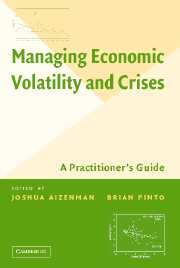Book contents
- Frontmatter
- Contents
- Contributors
- Acknowledgments
- Foreword
- MANAGING ECONOMIC VOLATILITY AND CRISES
- Overview
- PART I WHAT IS VOLATILITY AND WHY DOES IT MATTER?
- PART II COMMODITY PRICES AND VOLATILITY
- PART III FINANCE AND VOLATILITY
- PART IV MANAGING CRISES
- 8 Managing Macroeconomic Crises: Policy Lessons
- 9 Lessons from the Russian Crisis of 1998 and Recovery
- 10 Argentina's Macroeconomic Collapse: Causes and Lessons
- 11 Default Episodes in the 1980s and 1990s: What Have We Learned?
- Technical Appendix
- Index
- References
10 - Argentina's Macroeconomic Collapse: Causes and Lessons
Published online by Cambridge University Press: 25 July 2009
- Frontmatter
- Contents
- Contributors
- Acknowledgments
- Foreword
- MANAGING ECONOMIC VOLATILITY AND CRISES
- Overview
- PART I WHAT IS VOLATILITY AND WHY DOES IT MATTER?
- PART II COMMODITY PRICES AND VOLATILITY
- PART III FINANCE AND VOLATILITY
- PART IV MANAGING CRISES
- 8 Managing Macroeconomic Crises: Policy Lessons
- 9 Lessons from the Russian Crisis of 1998 and Recovery
- 10 Argentina's Macroeconomic Collapse: Causes and Lessons
- 11 Default Episodes in the 1980s and 1990s: What Have We Learned?
- Technical Appendix
- Index
- References
Summary
ABSTRACT: The Argentine crisis of 2002 has been variously blamed on fiscal imbalances, real overvaluation, and self-fulfilling investor pessimism triggering a capital flow reversal. This chapter provides an encompassing assessment of the role of these and other ingredients in the gestation of the crisis. Conceptually, the macroeconomic collapse must have resulted from much greater shocks than those hitting other countries, or from a weaker and more vulnerable policy framework, or both. In this framework, the chapter shows that in the final years of Convertibility, Argentina was not hit harder than other emerging markets by global terms-of-trade and financial disturbances. Hence the crisis primarily reflects the high vulnerability to shocks built into Argentina's policy framework. Three key sources of vulnerability are examined: the hard peg adopted against Optimal Currency Area considerations in a context of wage and price inflexibility; the fragile fiscal position resulting from an expansionary stance during the boom; and the pervasive mismatches in the portfolios of banks' borrowers. These vulnerabilities were mutually reinforcing, and severely constrained the room for maneuver available to the authorities – who failed to use it effectively while there was still time to avert the collapse.
WHAT CAUSED THE CRISIS
In the early 1990s, Argentina appeared to resurface from decades of instability and declining per capita income. Throughout much of the 1990s, under the one-peso–one-dollar rule of the Convertibility regime, the economy outperformed most other emerging markets, and Argentina managed to escape the aftershocks of Mexico's Tequila Crisis of 1994 relatively unscathed.
- Type
- Chapter
- Information
- Managing Economic Volatility and CrisesA Practitioner's Guide, pp. 439 - 470Publisher: Cambridge University PressPrint publication year: 2005
References
- 3
- Cited by

